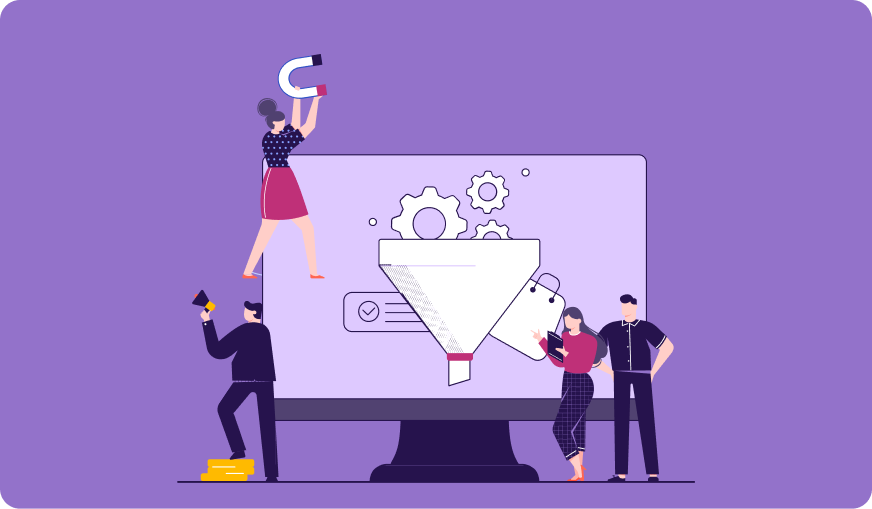Follow us and stay on top of everything CRO
Read summarized version with
What is website optimization?
Website optimization is the process of using tools, advanced strategies, and experiments to improve the performance of your website, further drive more traffic, increase conversions, and grow revenue using a/b testing and other methods.
One of the most critical aspects of website optimization is search engine optimization (SEO). The technique not only focuses on getting various pages of your website to rank high in the SERPs for specific keywords but enables prospects to find your brand in the easiest possible manner. The other critical aspect here is on-page optimization. This technique ensures that prospects that land on your website have the best user experience compelling them to take the desired action and convert into a lead.
So, by optimizing your website, you can not only tap into an untapped market in the most effective and efficient manner (without paying for advertising) but open doors to more conversions and revenue gains.
But, while SEO is an essential part of website optimization, it’s not the end-all-be-all of optimization.

Optimizing your website for real people helps you gain your visitors’ trust, starts building a relationship, and lets you sell products without having to jump on a sales call.
A holistic website optimization approach combines a variety of disciplines to make sure your website performs ideally in all areas:
- SEO
- Copywriting
- Analytics
- UX Design (Frontend)
- Web Development (Backend)
- CRO/Landing Page Optimization.
If you specifically want to maximize sales and leads from existing traffic, you should read our comprehensive guide on Conversion Rate Optimization (CRO) instead.

Why is website optimization important?
Over the past decade, the Internet has emerged as a primary platform for consumer purchases, with global online retail sales reaching $5.2 trillion in 2021 and projected to hit $8.1 trillion by 2026.
The Internet has also become the go-to destination to find information on local businesses (46% of total Google searches have local intent, and 78% of local mobile searches result in offline purchases) as well as software companies, B2B enterprises, and more.
The internet is taking over the role of “asking a friend” in all industries. So by positioning your business correctly, you can consistently turn people who had previously never heard of your company into customers.
If you don’t optimize your website and your content, it doesn’t matter how many people search for terms relevant to your business. Your site won’t show up in the results. Your website and your business won’t get noticed by anyone.
But when you do optimize for search, you put yourself on the map. Consumers will search for relevant terms, and your website and business will always show up.
By mastering Search Engine Optimization (SEO), you will generate targeted traffic from interested buyers.
But it’s not enough to just optimize for search alone. If you only grow your traffic, and your site’s content doesn’t appeal to potential customers, nobody will convert. Visitors will bounce from your website without making a single purchase.
To make use of the traffic, you also need to optimize the user experience and efficiency of your conversion funnels.
By mastering Conversion Rate Optimization (CRO), you maximize the number of leads and sales you generate from paid and organic traffic.
Another often overlooked benefit is that website optimization can lead to helping the environment. So when you do optimization, you can help reduce the carbon footprint of your website.
Read this article to discover the multitude of benefits and actionable strategies that can propel your online presence to new heights.

Benefits of website optimization
No matter what industry you belong to, optimizing your website offers many benefits that can positively impact your key business metrics and drive business growth.
Let’s look at some of the top benefits of website optimization.
1. Better user experience
The primary focus of website optimization is to help users achieve their desired goals on your website.
Whether they want to learn more about your product, navigate through the various offerings, or get in touch with a representative, website optimization makes it easier for users to complete the desired actions.
Thus, one of the most important benefits of optimizing your website is that it improves the user experience and ensures that your visitors have a seamless journey navigating through your pages.
A positive user experience not only builds trust but also encourages visitors to explore the website further, ultimately leading to higher engagement and conversion rates.
2. Improved visibility on SERPs
Ranking higher on search engines is tough, especially when your competitors are targeting similar audiences and keywords.
However, the key to grabbing that top spot on Google includes a combination of factors such as delivering valuable content, including relevant keywords, improving the page speed, ensuring mobile responsiveness, and so on.
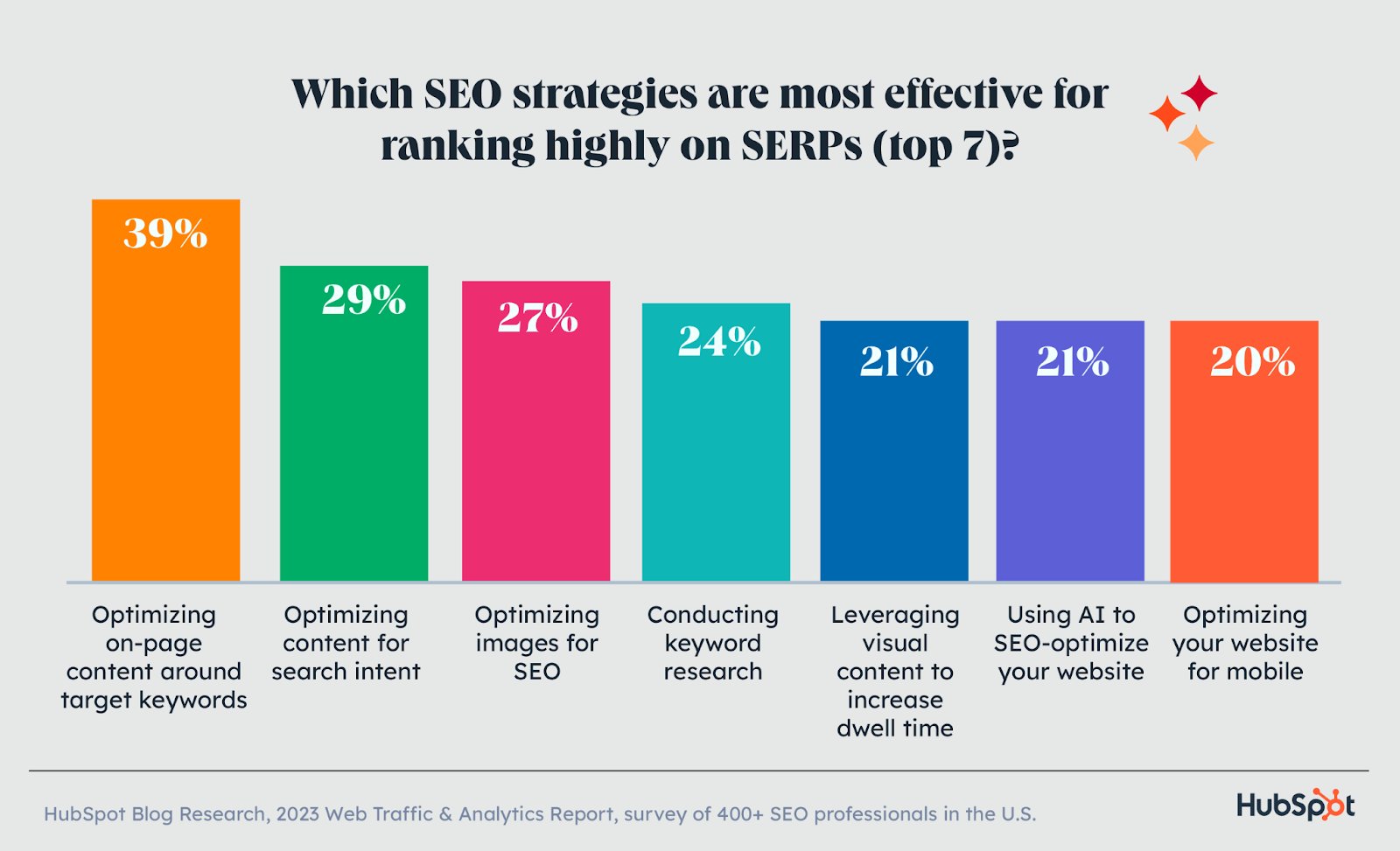
While these tasks may seem unrelated, they all fall under the umbrella of website optimization.
By continuously working on these factors, you can drive user engagement, boost the performance of your content, and also improve your website’s visibility among the SERPs.
3. Higher conversion rates
The primary focus of any website is to convert visitors into customers.
Website optimization helps you achieve this goal as it involves analyzing user behavior, using A/B testing to find the best version of a page or element, and optimizing key funnels that drive conversions.
Based on these key factors, you can fine-tune your website, guide visitors toward their desired goals, and help them take relevant actions. All of these factors can together boost the conversion rate of your website.
4. Discover friction points
While website optimization boosts user engagement and improves the overall experience, it also helps you identify the problem areas on your website.
Also known as friction points, these problem areas prevent your visitors from having a seamless experience on your website.
Whether it is a glitch on the page, slow loading time, unresponsive elements, or a confusing navigational structure, these friction points can cause frustration among users and can even lead to them abandoning your website altogether.
A key part of the website optimization process is identifying friction points through in-depth analysis of user behavior and fixing them to ensure that visitors have a seamless, enjoyable experience.
This not only improves user engagement but also sends positive signals to search engines, further boosting your website’s visibility and credibility.
5. Gather insights into visitor behavior
Website optimization involves analyzing user data and metrics to identify areas for improvement and track performance over time.
By leveraging both quantitative and qualitative analysis, you gain valuable insights into user behavior, preferences, and trends. With quantitative analytics tools like Google Analytics, you can get crucial data about website performance like bounce rate, conversion rate, etc.
However, by using behavioral analytics tools like VWO Insights – Web, you can gain deeper insights into specific actions that visitors take on your website.
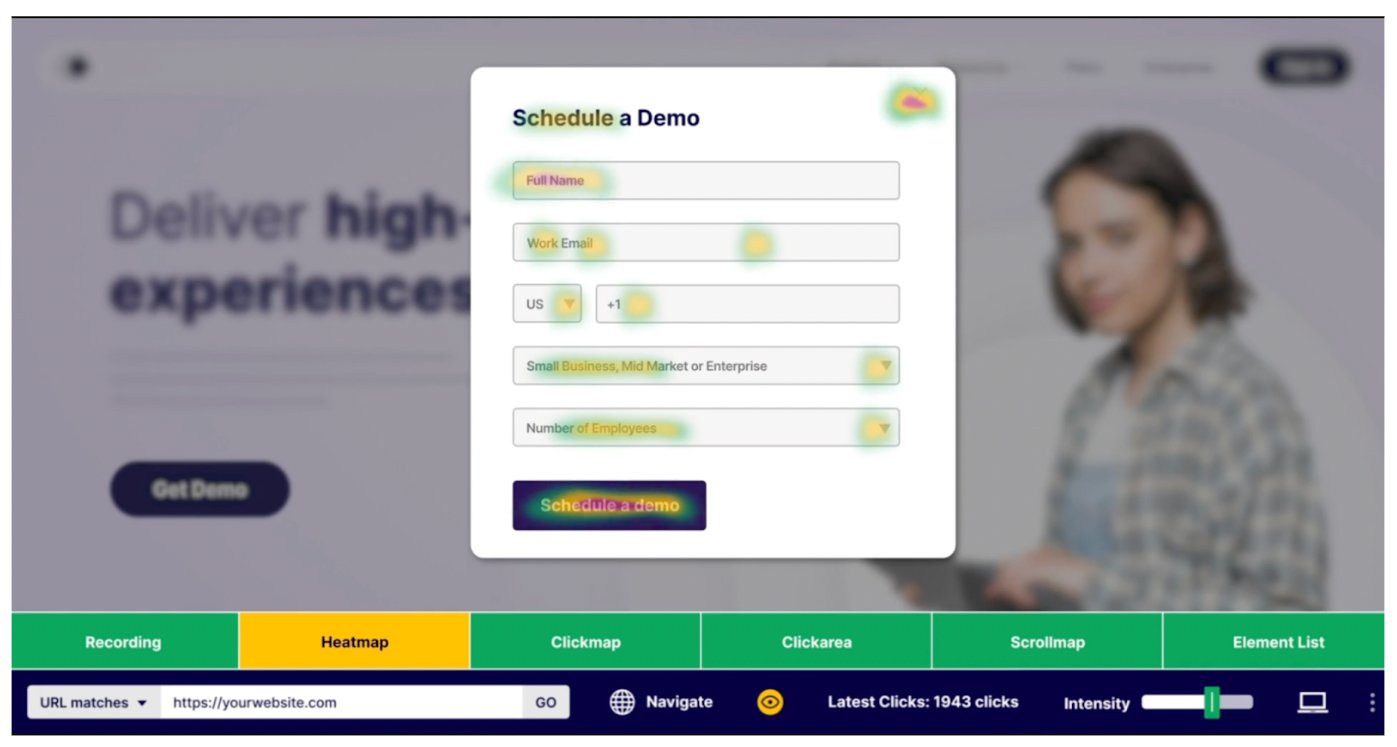
This data-driven approach enables you to make informed decisions and tailor your optimization efforts better to meet the needs and expectations of your target audience.
6. Reduced customer acquisition costs
As you continue to optimize your website, you build an experience that caters to the unique needs, challenges, and requirements of your visitors.
This also gives you a deeper understanding of their behavior, allowing you to create a cycle of ongoing improvement and helping you to convert more visitors into customers.
Not only does this reduce the cost of acquiring new customers, but it also helps you to focus your efforts on building a website that is optimized for every visitor.
7. Effective, long-term growth
Website optimization is not a one-time fix.
Instead, it is an ongoing process where you continuously analyze visitor behavior, identify the key problem areas, improve crucial conversion paths, and boost the overall user experience.
Each of these steps is key to the growth and success of your business in the long term as it helps you to stay on top of evolving audience behaviors and also allows you to adapt to changing industry trends.
A solid website optimization strategy gives you a huge competitive advantage and helps you boost conversions and drive long-term growth.
How does website optimization work?
The goal of website optimization is to make your site as appealing to search engines and real people as possible. But how do you do that?
The first step to making anything better is to identify issues. You need to find out what’s wrong with your current site before you can improve it.
That’s the foundation of any great optimization process.
It’s not enough to just brainstorm potential issues with your team. You don’t have the bandwidth or experience to cover all areas. Instead, you should use available software tools to search for potential issues with SEO, page speed, mobile usability, and more.
Below we’ve created a table overview of all major optimization areas, relevant tools, and benchmarks you should meet or exceed to get results.
| Area | Optimization Tool | Benchmarks |
| Page Loading Speed | Page Speed Insights | 90+ score and subsecond first meaningful paint. |
| Mobile Usability | Mobile-Friendly Test | No issues and a “page is mobile-friendly” message. |
| SEO (Backlinks & DR) | Ahrefs, SEMRush, Moz | Higher domain rating and more backlinks than top competitors. |
| SEO (Technical On-Page SEO) | Ahrefs, SEMRush, Moz | Ahrefs: Health Score of 80%+SEMRush: SEO Audit Score of 80%+Moz: Page Optimization Score of 80+ |
| SEO (Content) | SEMRush (SEO Writing Assistant), MarketMuse | Benchmarks depend on each keyword’s competitiveness. |
| CRO (A/B Testing) | VWO Testing | Conversion rate benchmarks depend on the industry, but 5.5% is the average for all industries. |
Finally, you should test the usability of your site with unaffiliated test users. The results will give you a roadmap where you can coordinate optimization efforts with different teams.
Content writers can improve the content, website managers can improve site structure and other on-page SEO issues, and designers can improve user experience as well as the look and feel of your site.

5 website speed optimization techniques
Page load speed is one of the most crucial factors that can impact the ranking, performance, and overall experience of your website.
While the average page load time for websites is 2.5 seconds, a study by Backlinko found that the average page load speed of sites ranking on the first page of Google is just 1.65 seconds.
This is why it is important to continuously improve the speed and achieve faster load times for your website. Here are 5 key website speed optimization techniques that you can implement.
1. Focus on above-the-fold content
The above-the-fold section refers to the part of the website that appears when a page loads before the visitor scrolls down.
By placing the most important content like impactful headlines, primary CTAs, and relevant hero images in this section, you can ensure that visitors see crucial information as soon as they land on your page.
This is helpful as your visitors can still interact with important content while the page is still loading, thus preventing immediate drop-offs.
2. Optimize every image on your page
One of the best ways to boost website performance is to optimize the images that appear on each page.
The most effective method to do this is to compress the images with tools like Photoshop, or ImageOptim that not only reduce the file size of images but also maintain the visual quality.
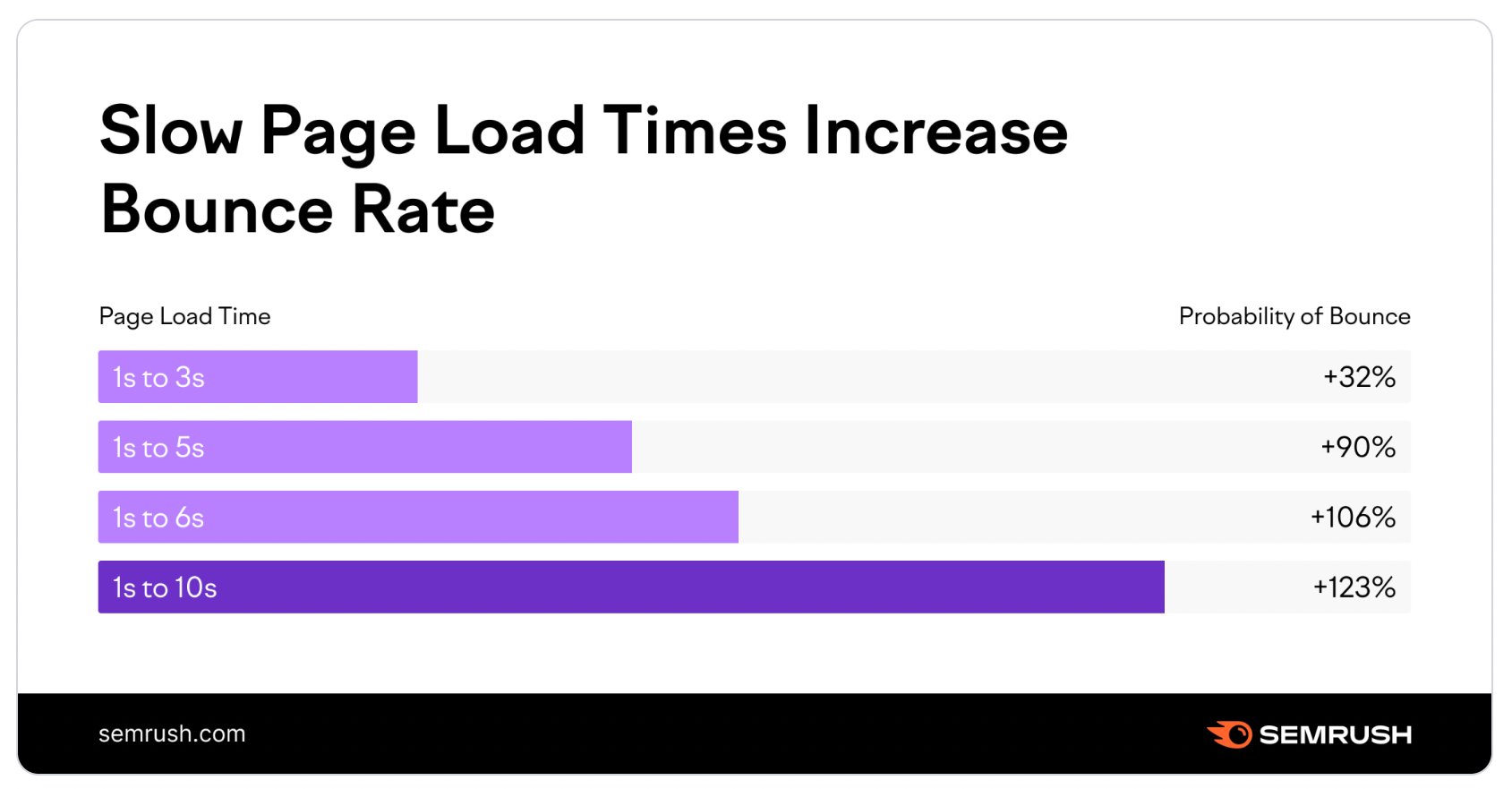
Another useful website performance optimization technique is to use formats like WebP for your images as it offers better compression as compared to common image formats like JPEG or PNG.
3. Use tools that have minimal impact on page load speed
Website optimization usually involves the use of various tools and analytics software that give you insights and help you improve the user experience.
However, the integration of these tools with your website can sometimes impact your website performance as they often increase the load time of your pages.
This is why it is important to rely on tools that not only help with website optimization but also have minimum impact on the speed of your website.
For example, VWO requires you to install a code snippet, known as VWO SmartCode that allows your website to interact with VWO’s servers.
However, this code snippet has minimal impact on the load time of your website as it loads in parallel with your webpage. This means that the website speed is not affected by the addition of the code snippet and also ensures a seamless experience for your visitors.
4. Implement lazy loading for better website performance
Lazy loading refers to the concept of delaying the rendering of images, videos, or other content on a page until the visitor or browser needs it.
This is an effective website performance optimization technique, especially for pages that have a lot of images or videos. Not only does it delay the loading of such non-essential content, but it also ensures that the important content is loaded first.
By combining lazy loading with a responsive website design, you can significantly improve the performance of your website and focus on optimizing the important content that appears first.
5. Use a CDN to greatly improve page speed
Another way you can offset the load of images is by hosting all your media files and scripts via a Content Delivery Network (CDN).
A CDN is a network of data centers around the globe. It will deliver your file to the visitor from the server closest to their physical location. Using one can significantly speed up loading times, as the physical distance the data has to travel will be a lot shorter.
Cloudflare and Amazon CloudFront are two of the most popular options on the market.
Website navigation optimization techniques
Website navigation is crucial in delivering an exceptional user experience and driving conversions. An optimized navigation system ensures users can effortlessly find the information they need, reducing bounce rates and improving engagement.
Core strategies for optimizing website navigation include:
- Understanding user needs through research (interviews, surveys, usability testing, heatmaps, session recordings)
- Developing a clear information architecture with logical content organization and grouping
- Optimizing website structure (hierarchical or linear/sequential navigation models)
- Thoughtfully designing navigation menus (horizontal, dropdown, hamburger, vertical sidebar, footer, mega menu)
- Employing best practices like clear labeling, strategic internal linking, mobile-friendly design, and visual distinction
- Incorporating additional navigation methods (breadcrumbs, sticky menus, contextual navigation, pagination, faceted navigation, gamification)
- Continuously optimizing through A/B testing, user feedback collection, and data-driven improvements
By prioritizing navigation optimization, businesses can create intuitive, user-centric experiences that boost engagement, enhance SEO, and ultimately drive conversions.
How to optimize your website for search engines (SEO)?
How do I optimize my website for search engines?
That is a critical question you need to answer to make the most out of your website.
Or, since Google has a 75.23% global search engine market share, you specifically need to understand how to optimize for Google.
In this section, you will learn how to figure out what your potential customers are searching for on Google, how to tailor content to their searches, and what you need to do to start ranking pages in the search results.
1. Keyword research: Figure out what your customers are searching for
The foundation of any SEO tactic, strategy, or process is keyword research. You need to understand which keywords and terms your target customers are actively googling.
This knowledge will help you with everything from planning and writing content for your website to creating landing pages, and campaigns, and tracking your results.
There are a lot of different tools for keyword research out there, but the most basic option is available for free: Google Ads Keyword Planner.
If you have a Google Ads account, you can use it to search for new keywords to target with ad campaigns, but it’s also useful as a starter research tool for SEO.

Start with a broad keyword or your industry/product category. Google will pull search statistics for all relevant keywords, and show you how much advertisers are willing to pay to advertise for them.

The “Competition” column shows how many advertisers are targeting the keyword and doesn’t necessarily reflect the SEO competition.
Keywords with high “top of page bids” typically reflect keywords that have high “commercial intent.” Companies are willing to pay a lot of money for each click, which means these keywords likely have a high percentage of searchers actively looking to purchase a product or service.
When a user searches for “What is a CRM?” They are just looking for information. If they search for the “best CRM for small businesses,” they are actively looking for a product.
That’s an example of a keyword with high commercial intent.
You want to identify a list of keywords that meet the following requirements:
- They have a significant search volume (worthwhile volumes will vary based on your business and the intent of the term).
- They are directly relevant to your products and services.
- The competition is low enough that you have a chance of ranking.
- Bonus: They indicate high purchase intent.
Google Keyword Planner can help you find relevant keywords with a high search volume and good intent, but it doesn’t give you any data on competitiveness.
You could manually Google each of the keywords and look at every top search result, but that’s not an efficient approach.
To find golden opportunities for new content at scale, 99% of SEO professionals rely on third-party SEO tools. The three most popular tools are Ahrefs, Moz, and SEMRush.
With Ahrefs, you can see the competitiveness of any keyword as the difficulty score in the top corner of their “Keywords Explorer” tool.
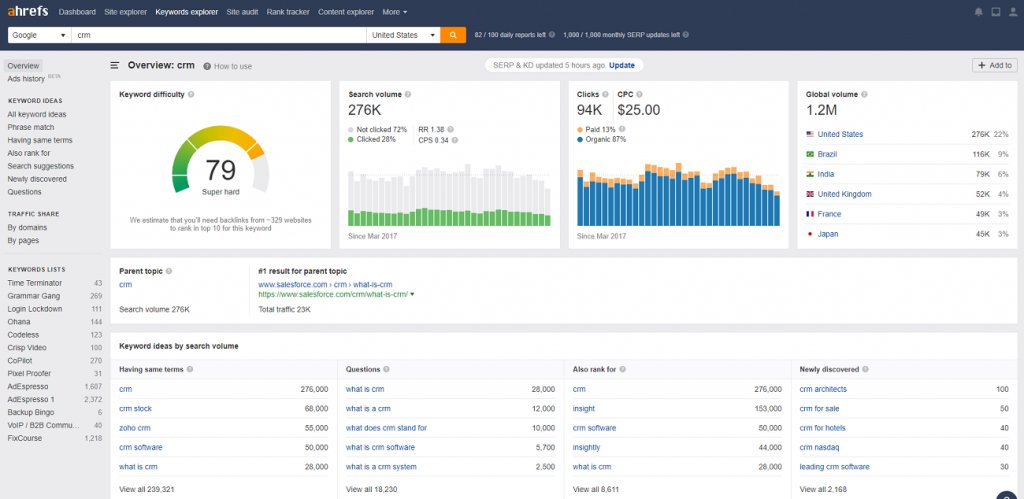
You can also see detailed information about the top results, including the number of backlinks, word counts, and more.
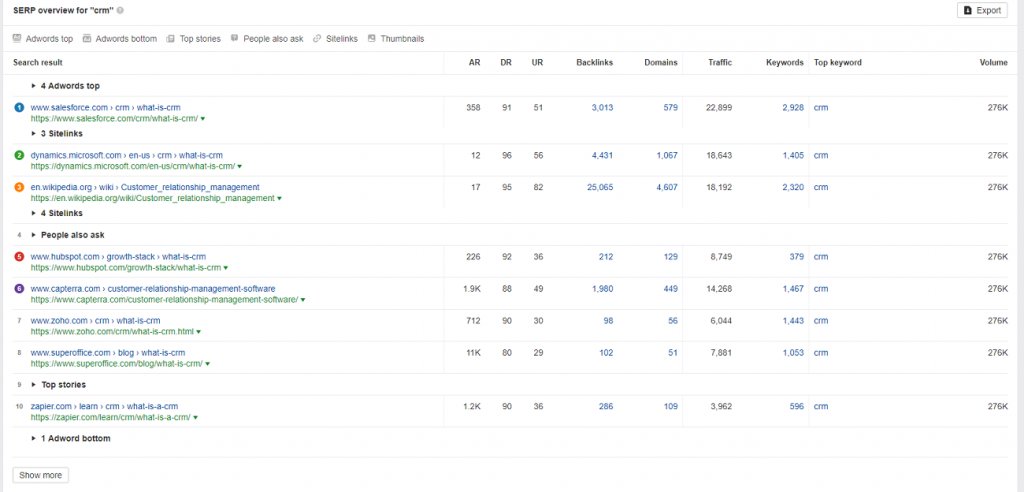
You also have tools for exploring competitor sites, their keywords, and borrowing their ideas.
With a third-party SEO tool, you can easily find keyword opportunities that you should create content around.
Many keywords are also perfect for post titles and URL slugs already, so you don’t even need to come up with headlines if you do your keyword research right.
Keywords can be turned directly into headlines like “What is a CRM?” and “The Best CRM for Small Businesses.”
2. On-page-SEO: How to optimize your website content
It’s not just the pages you decide to create that impact your SEO. How the content is written, the content’s structure, your site’s structure, navigation, external links, and many other little details matter.
These SEO optimizations you can make by just editing your website are referred to as on-page SEO. And it can make a massive difference.
In a case study, only optimizing on-page SEO improved the top 5 keywords’ average position from 18.4 to 2.6 in only three days.
As mentioned above, you can use Google Search Console to search for issues and indexation errors. But you can also analyze other on-page factors.
The key is to make sure that important SEO pages receive priority when it comes to internal links.
Instead, what you often see when you open the “Top linked page – internally” report, are pages like “about” and “contact”:
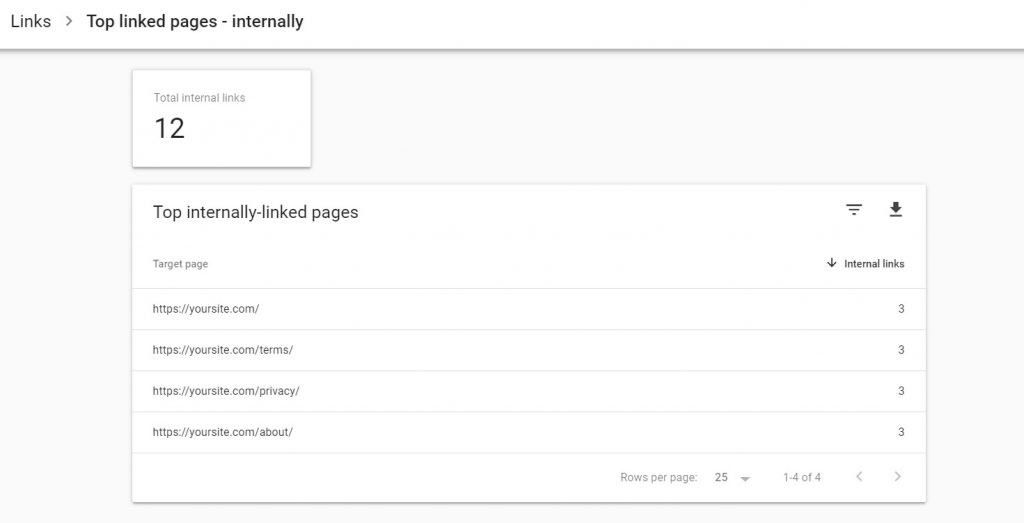
Of course, these pages are essential, and you have to link to them, but they should not be the only internal links you have. You should also highlight important cornerstone pages with links from all relevant content pages.
When it comes to finding and fixing all your technical on-page SEO issues, it’s easier to do with a third-party solution.
With Ahrefs and similar tools, you can run a site audit that identifies indexation issues, HTML tag errors, and other problems with on-page SEO. You can even schedule it to run on an ongoing basis.

When you open individual reports, you can highlight different issues (like HTML tags):

A popular, free tool that can do much of the same is the Screaming Frog SEO Spider.
But both these tools only help you look for technical issues.
How you write your content, and which words you choose to use can also have a significant impact on your rankings.
So, in addition to technical on-page SEO, you can also use a content-focused tool like MarketMuse to analyze already-ranking content and ensure that you cover as many relevant topics and terms as possible in your own content.
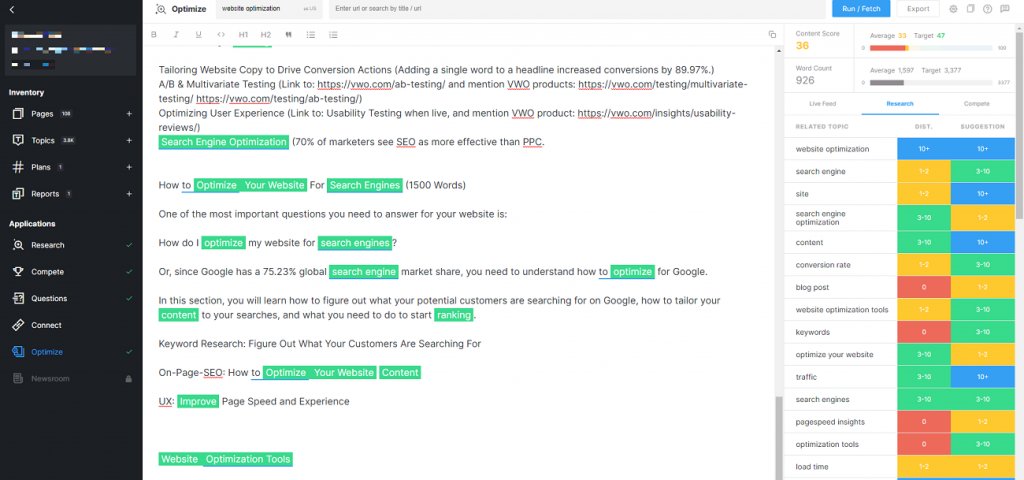
If you use a CMS like WordPress, you can use an SEO plugin like Yoast to input all the necessary metadata for your posts and pages.
It might seem like a lot of different tools, but it’s simply not viable to find, categorize, and fix all issues manually.
3. UX: Improve page speed and experience
Dwell time is an important SEO ranking factor. It measures how much time, on average, a user spends on your page before returning to Google.
If a user clicks your page in the search results, visits your site, and it takes too long to load, chances are they will just return to Google and choose something else.
So the visitor left without meaningful interaction with your site and brand. And if it happens too much, Google will assume that your page isn’t as relevant as they thought, and reduce your rank over time.
The more this happens, the lower your Google position is likely to be.
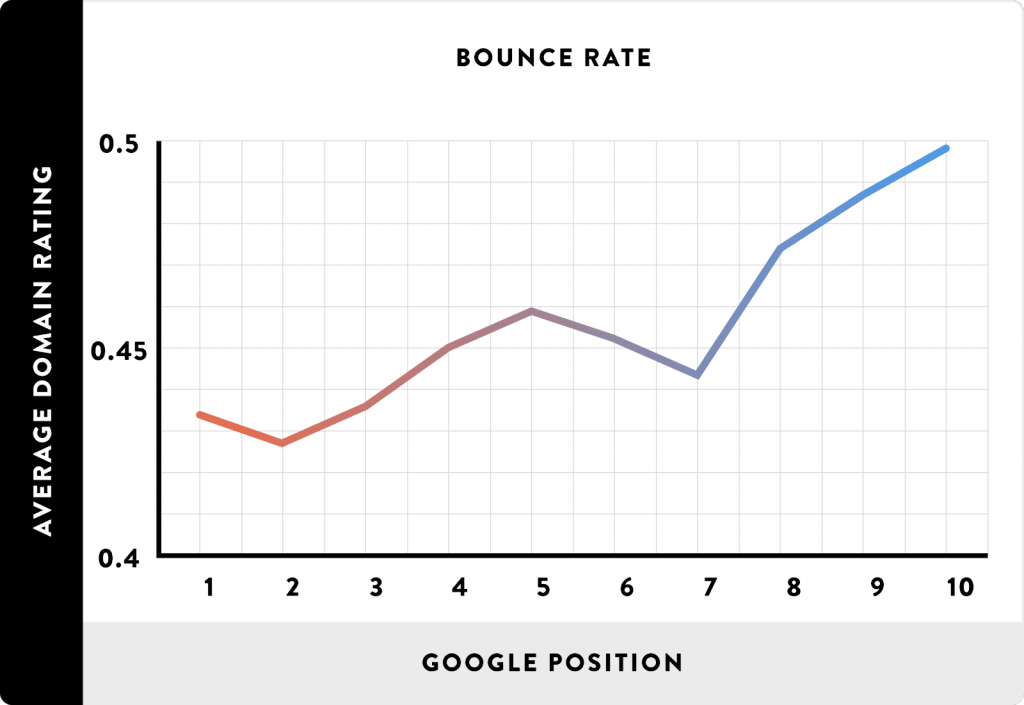
To remove these unnecessary bounces, you need to speed up your website.
Test the speed of your website and identify your main loading problems, with Pingdom Tools or another option like Pagespeed Insights, GTMetrix, or WebPage Test.
Type in your URL, select a server location, and click the “start test” button. Chances are, you won’t get perfect results.
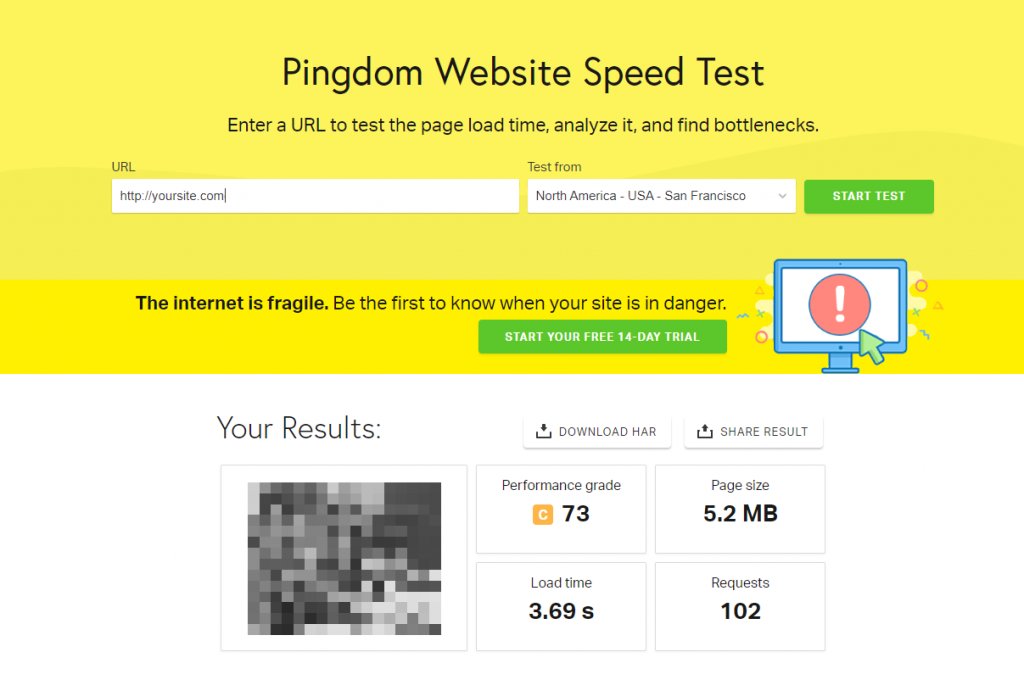
Once finished, the test results will give you a roadmap of issues to fix. Scroll down to see the actual details and advice.
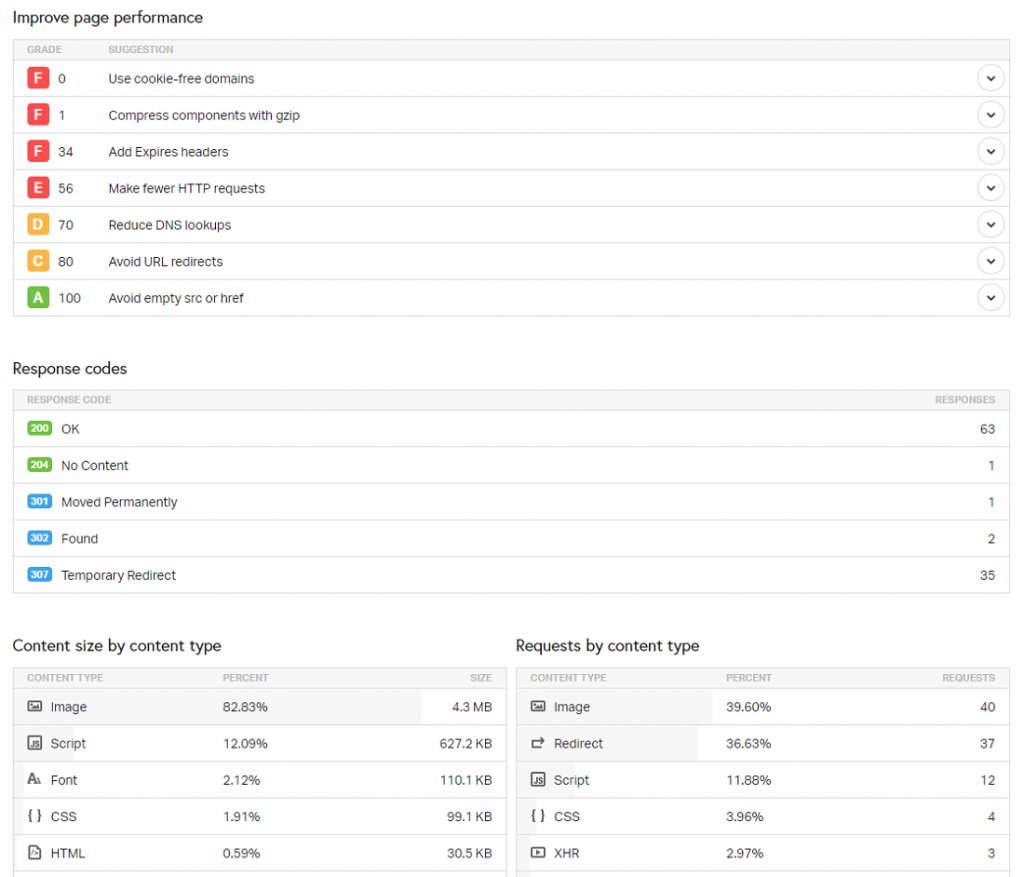
As you can see above, the tested website has too many HTTP requests, many uncompressed components, large image files, and other issues.
A few rules of thumb to improve the speed of your website:
- Have a high-quality dedicated server or cloud hosting plan. (Cheap, shared plans can often lead to slow page load times.)
- Use a CDN for media files and scripts.
- Implement page caching if you use a CMS like WordPress.
- Minimize the number of HTTP requests by keeping things simple, and using a select few JS and CSS libraries throughout your pages.
- If you have to include a lot of images throughout the page, implement lazyload and responsive images.
Keep fixing these issues until you get scores of 90+ and preferably a subsecond load time on domestic servers.
But it’s not just loading speed that can reduce your dwell time and rankings. If you have a clunky design or a funky font that makes it hard to read content, that will also impact how long visitors are willing to stay on your page.
The average time they spend on your site will impact your Google position and your results from all your other SEO efforts.
So you need to make sure that your site’s user experience is on point. An excellent place to start to understand the usability of your website is to analyze how current users are interacting with it.
To get real data on this, you can look at individual recorded user sessions and heatmaps. These reports will show you how customers interact with individual pages and elements in detail.
If you still find it hard to identify the problems, you should take the next step and get started with usability testing.
Once you have identified problems, you can test solutions through further benchmark usability tests, or split testing.
4. Backlinks: Get more sites to share your content
A backlink, or a link from another domain to your website, is one of the most important signals to Google that your content is authoritative.
The idea is simple. Since other people are willing to share and co-sign your content, it must be good.
It used to be the most important ranking factor, bar none, and the number of referring domains still has the most visible connection with SERP ranking and organic traffic volume.

But how do you get more backlinks? There are tons of strategies and tactics, but it all boils down to these two steps:
- Create content worth linking to.
- Find and contact people with relevant sites/outlets who are likely to share your content.
If it’s a standard how-to or list post, it has to be more extensive and better than all the content that currently ranks on Google.
Brian Dean, the mastermind behind the SEO blog Backlinko, has perfected this approach into a repeatable strategy, called the Skyscraper Technique.
First, you analyze the SERPs for different keywords until you find top-ranking pages that are clearly dated or otherwise unsatisfactory. Then, you make a list of sites that link to the dated article/guide.
Invest the time and money required to create a more up-to-date, better piece of content and reach out to the site owners that linked to the original dated/lacking articles.
In itself, the skyscraper technique page fits into another category of highly linkable content: original case studies and research.
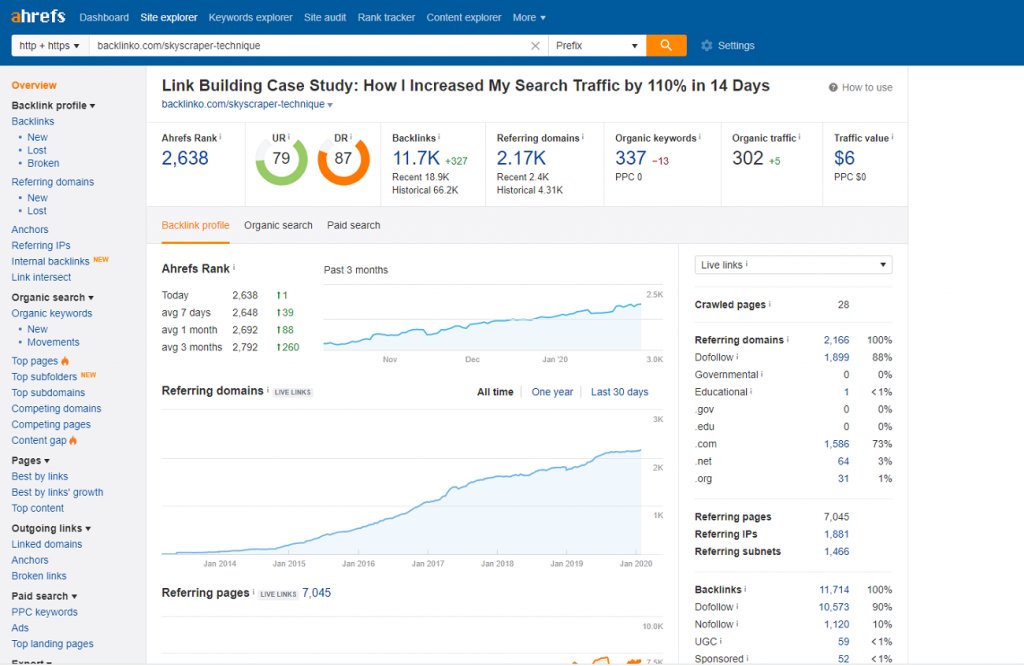
Just this one page has over 2,000 referring domains and over 11,000 organic backlinks. The reason? It’s not just a post; it’s a detailed case study that shares actual statistics and results.
And case studies and research are very effective link magnets for a reason. Web content writers love to use statistics and case studies to back up their points. So one of the best ways to get links is to do original research, publish user/company data, or release a case study.
You can also repurpose lesser-known, recent research to create infographics that highlight the conclusions and make the data accessible to laypeople.
5. Learn advanced techniques and tackle more ranking factors
Once you’ve learned the basics of SEO, it’s time for you to jump in and learn more about different ranking factors and advanced strategies.
There are over 200 known Google ranking factors out there, so obviously getting familiar with each one and using it to your advantage is going to take time.
To keep learning about the subject of SEO, you must rely on high-quality resources that focus on data-based content and cutting-edge strategies.
The following is a non-exhaustive list of websites you can rely on to expand your SEO knowledge:
- Backlinko
- Ahrefs Blog
- SEMRush Blog
- Moz Blog
- Search Engine Journal
- Search Engine Land
- Yoast
- Cognitive SEO
- Matthew Woodward
- ClickMinded
Visit a few of the sites, check out their basic and advanced guides on SEO, and see which content style you find the easiest to consume.
Make sure you bookmark relevant posts and create custom checklist documents to follow through on techniques that you learn.
Optimizing your SEO is not something that you will be able to do in a day or a week. It is a long, challenging process that you have to dedicate yourself to over the long term.
How to optimize your website for sales and conversions?
If you rely on social media or digital advertising to drive traffic, SEO shouldn’t be your main priority. It should be how to maximize your traffic to get as many leads and sales as possible.
If you already get a significant amount of organic traffic, but very few conversions, it’s the same story. You will get the biggest return on investment by focusing on converting as many visitors as possible.
You can do this by looking at the data and finding bottlenecks and underperforming pages. From there, you can ideate and create potential solutions, and finally, put them to the test against the original page. This process is called Conversion Rate Optimization (CRO) or landing page optimization.
Previous tests and case studies show that it’s possible to increase your conversion rates by up to 125% by following this process and testing multiple solutions.
To get the most out of your existing traffic, follow the six steps below.
1. Understand your target market
Before you can start to optimize a digital sales process, you need to understand your target market.
A good place to start is to answer the questions below.
- Who are your ideal customers? (Focus on essential details like positions, industries, and company sizes, as well as individual hobbies, etc.)
- Why do they need your product? (Focus on real, tangible problems like losing customers or wasting hours each week on an inefficient publishing process.)
- Are they currently using a competitor’s product?
- What are their biggest pain points with their current solution?
- What is their budget for products like yours? What are customers paying for competitor products?
You should be able to answer basic questions like this, and ideally, you have already constructed detailed and accurate buyer personas.
An understanding of your potential customer base is the foundation of a healthy conversion funnel. It will help you identify potential issues with your content, site structure, and sales funnel.
2. Analyze current user behavior
If you understand who your ideal buyer is, you’re ready to move on to the next step. Track how all visitors interact with your website to find potential bottlenecks and failure points in your funnel.
If you use Google Analytics, make sure you check out behavior reports like “behavior flow” and exit pages.
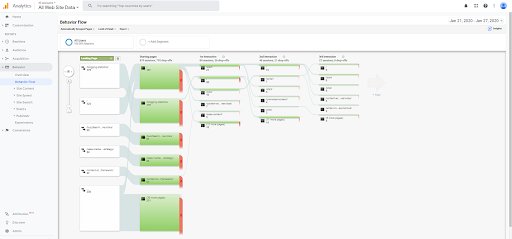
They will show you how people enter your funnel, and which pages cause visitors to leave instead of converting or continuing.
But GA can’t give you a holistic image of how your visitors interact with individual pages of your site in real time.
For that, you need to use other, more specialized tools. With modern analytics tools such as VWO’s AI-powered free heatmap generator, you can track visitor attention and use this information to your leverage.
You can not just see what page they leave on, but what the last headline and content element they interacted with was. So instead of having to guess what’s wrong with a page, you will have clear data that highlights lackluster elements and uncompelling copy.
You can also implement exit surveys, session recordings, and more to get a complete image of how visitors are interacting with every page on your website.
Together, these insights will give you the context you need to start ideating tests to improve your site.
3. Improve usability
Once you’ve identified problem areas on your website, where visitors drop off, you need to figure out how to solve the problem.
Sometimes it’s not related to poor design or copy. It can be a usability issue where your potential customer gets confused or fed up with the process and leaves.
To find and eliminate fundamental UX problems, you can implement usability reviews with real people. In essence, test users try to complete different tasks on your website and report problems they encountered at each step.
It gives your team an accurate representation of how your customers experience your website in real time and the struggles they face.
You can also use these reviews to benchmark potential solutions before running site-wide tests.
4. Use copywriting best practices
The words and sentences you choose to use on your website can set you up for success or devastating failure.
The power of a single word can make or break an advertising campaign, and it can do the same for your landing pages.
Make sure that you follow copywriting best practices for all your content.
Use a copywriting framework like PAS (Problem Agitate Solution)[12] and learn from successful copywriting examples from competitors and established brands.
You should always cover these basics:
- Use compelling headlines that address your customer’s problems/desires. (Why should they care?)
- Insert a clear Call to Action (CTA) on all important pages. (What should they do?)
- Highlight benefits over features. (How does your product change their lives for the better?)
- Use bullet points to summarize key selling points.
- Write about them, not about your product. (Use the words “you” more than “us” and “we.”)
- Edit your copy to be as clear and concise as possible.
Your writers must also understand where in the funnel the visitor is on every page. It will allow them to edit individual page content for clarity and relevance.
Top-of-the-funnel content will need to explain basic concepts and jargon, while for the bottom-of-the-funnel content, you can write for a more advanced audience.
5. Use A/B and multivariate testing to develop the best landing pages
Once you have identified issues and created a potential solution, you must run an A/B test that compares the new page against the original.
For example, let’s say that you noticed that very few users interacted with a CTA button and proceeded to scroll past it on the page. You could test new colors, a larger size, or a different copy for the button.
A multivariate test will quickly highlight the best possible solution to the problem. It’s the perfect last step for optimizing a page.
You can also develop tests based on ideas from your marketing or sales team, without the extensive analysis up-front.
A fast-paced testing culture is essential to consistently improve your conversion rates and UX over the long term and can lead to new insights into your customers and what makes them tick.
Here are 23 A/B testing ideas to get your team started on improving your conversion rates and landing pages.
6. Implement cart abandonment & remarketing campaigns
No matter how much you optimize your site, cart abandonment will still be a prevalent issue.
The average results from 41 different studies show that the average cart abandonment rate is almost 70%. So out of every ten potential customers, on average, ecommerce stores lose seven before they finalize the purchase.
Even with perfect copy and excellent UX, you will still experience this problem. So to reach those customers again, before they buy the items from competitors, you want to implement cart abandonment campaigns.
A cart abandonment campaign is a website marketing optimization campaign that targets users who leave a cart before checking out and reminds them that the cart is still open with the items they chose. You can also offer a discount or coupon to seal the deal.
You can create these campaigns by using a marketing automation tool that integrates with your eCommerce platform. Popular solutions like Shopify, BigCommerce, and WooCommerce integrate with most providers.
In the past, the most common medium was email, but now you can use new channels like Push and Facebook Messenger as well.
Navigating the essentials of website design
Understanding website design optimization involves refining various aspects such as structure, content, and design elements to enhance performance, engagement, and conversions. It’s about crafting a seamless user experience while achieving business objectives.
A well-optimized website includes elements that encourage users to take action, like clicking a button. It also ensures smooth performance, appealing visuals, easy navigation, and compatibility with different web browsers and your brand’s style.
To engage users effectively, you need to design with their preferences in mind, use clear call-to-action buttons, and incorporate trust-building elements such as testimonials. Performance optimization involves making sure your website works well on mobile devices, loads quickly performs efficiently, and is ready for search engine optimization (SEO).
In terms of visuals, your site should sport eye-catching fonts, compelling main images, and high-quality product images. Making things easy to find means organizing content logically and ensuring accessibility for everyone.
Navigation elements emphasize clear structures and accessibility, while additional considerations like cross-browser compatibility and branding play vital roles in creating a cohesive and memorable online presence.
With the multitude of websites competing for attention, continuous evaluation and optimization are crucial to ensure your website stands out, captures user interest, and drives conversions.
Strategies like A/B testing and split-URL testing can further validate design decisions, keep your website ahead of the competition, and deliver exceptional user experiences.
6 crucial website optimization tips
Optimizing your website can be a large project, taking tens or even hundreds of working hours to complete.
Besides, when the potential rewards are so substantial, you don’t want your efforts to be sidelined by an avoidable mistake.
Below, you can find our eight top optimization tips that will help you complete the process without issue.
1. Always backup your site before implementing changes
Once you’ve figured out a problem, and you’re ready to test or implement changes, always back up your website.
If you use a third-party testing tool to A/B test changes, you don’t need to do this during the testing phase.
But if a test beats the control, you should always complete a backup before making the changes live.
If your site runs on WordPress, you can use a plugin like UpdraftPlus to back it up without issue.
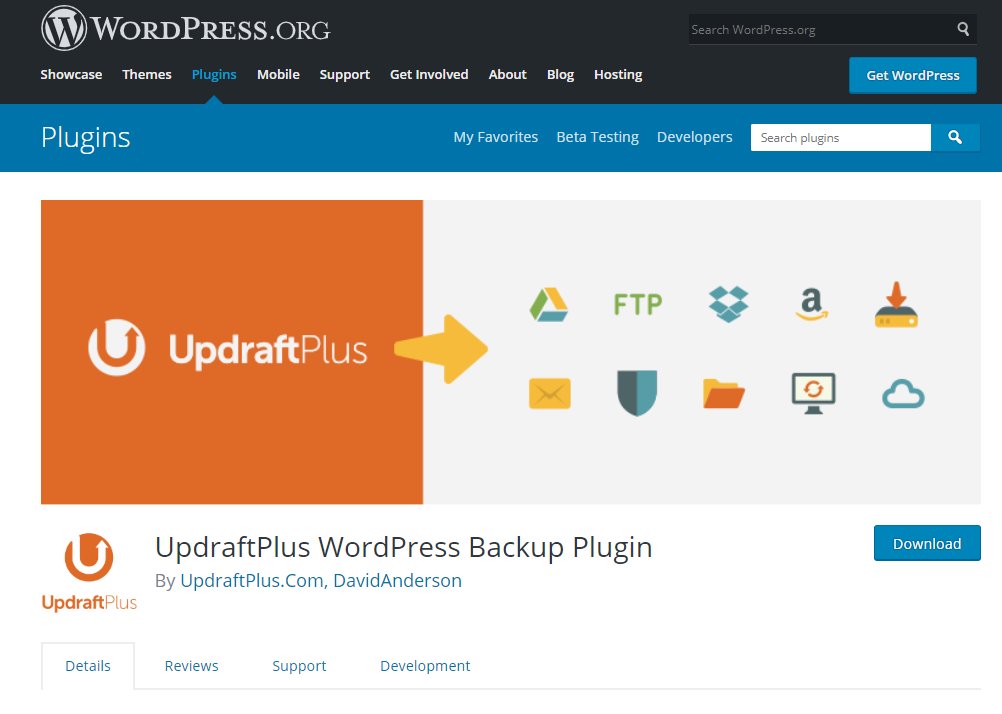
If you developed your CMS in-house, you could still rely on third-party solutions like Drop My Site or Carbonite.
2. Use a CDN to greatly improve page speed
Another way you can offset the load of images is by hosting all your media files and scripts via a Content Delivery Network (CDN).
A CDN is a network of data centers around the globe. It will deliver your file to the visitor from the server closest to their physical location. Using one can significantly speed up loading times, as the physical distance the data has to travel will be a lot shorter.
Cloudflare and Amazon CloudFront are two of the most popular options on the market.
3. Tailoring website copy to drive conversions
The words you use on your website matter more than you think. Design, images, usability, and page speed are all crucial factors, but words control your message.
And, while words are the easiest thing to change, they can also be the most powerful.
Case studies show the power of web copy all the time. In one instance, adding a single word to a headline increased conversions by 89.97%.
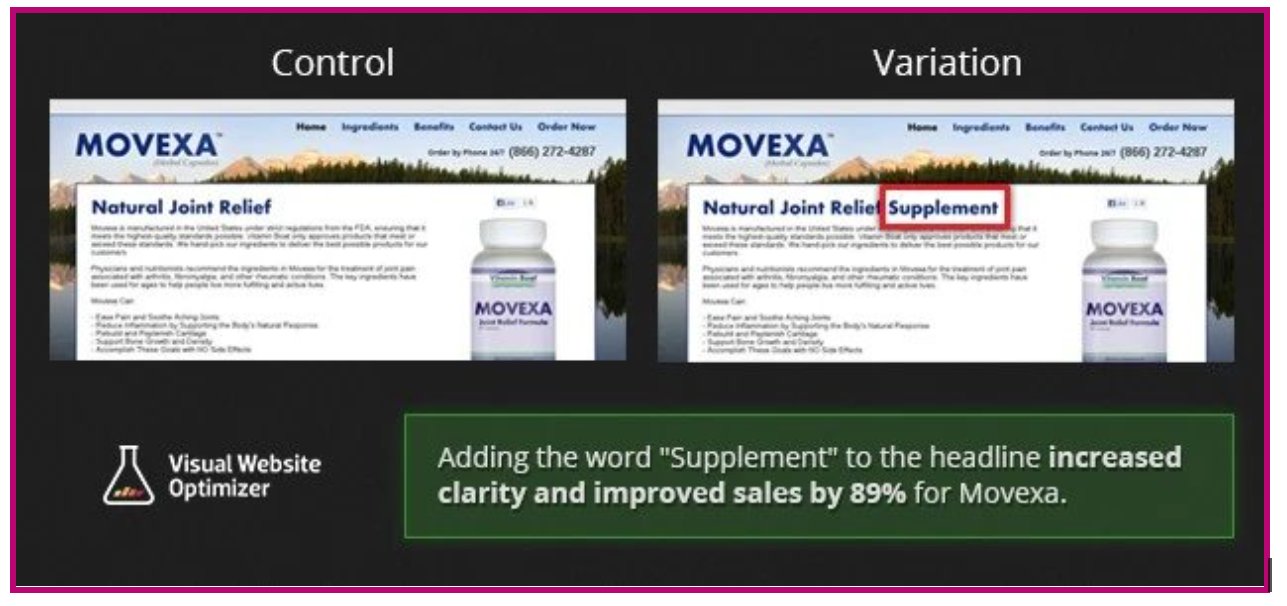
So don’t rush through your content. You want the copy on each page to provide a logical roadmap towards the conversion action you want them to take.
To do this, you not only need to understand basic website copywriting techniques but also your customer base.
If you don’t understand the problems, desires, and doubts of your visitors, you can’t create a journey in words that will guide them to the destination you want.
Analyze in-depth user data like heatmaps to get to know the customer journey, and talk to existing customers about their doubts and what convinced them to purchase.
Once you’ve identified an area with a weak copy on your website, you can ideate and test different copy variations based on what you know about your customers.
4. Use social proof to increase trust
When visitors first come to your website, they might not know anything about your company. Since the relationship starts from scratch, you have to earn their trust with your content.
And few years back, only 59% of consumers responded that they trusted businesses. So just talking about yourself isn’t going to cut it.
You need to highlight actual customer experiences on your site. 84% of people trust online reviews as much as their friends. Positive reviews, testimonials, and other social proof are some of the most powerful selling tools you can use on your landing pages.
5. Optimize the entire customer journey
A common mistake when it comes to A/B testing and CRO is focusing only on a single page or area of the site.
Yes, product pages and landing pages are essential, but they’re not the only things that contribute to your sales.
For example, if you could optimize your search results to get 30% more people onto product pages, that’s automatically a massive jump in sales.
Optimize every stage in the entire customer journey to get the best results in the long term.
6. Optimizing the mobile experience
The majority of internet traffic has moved to smartphones. It’s a new era. You must optimize website for mobile, including checkout and post-purchase tasks like checking in or contacting customer support.
It’s no longer enough to have a website that looks and works great on laptops and desktop computers. To succeed in the online marketplace, you need to focus on your site’s mobile experience as well.
The majority of all traffic (52.2%) in 2018 was mobile. Not to mention, most Google searches now happen on smartphones. In Q3 2019, 64% of Google searches were made on mobile.
Because of this, Google has already switched to mobile-first indexing, where they primarily index and rank your mobile pages. So any issues can cost you not just potential mobile conversions, but the opportunity to rank highly for relevant search terms.
So the first thing you want to do is run a basic mobile usability test, for example, Google’s Mobile-Friendly Test.
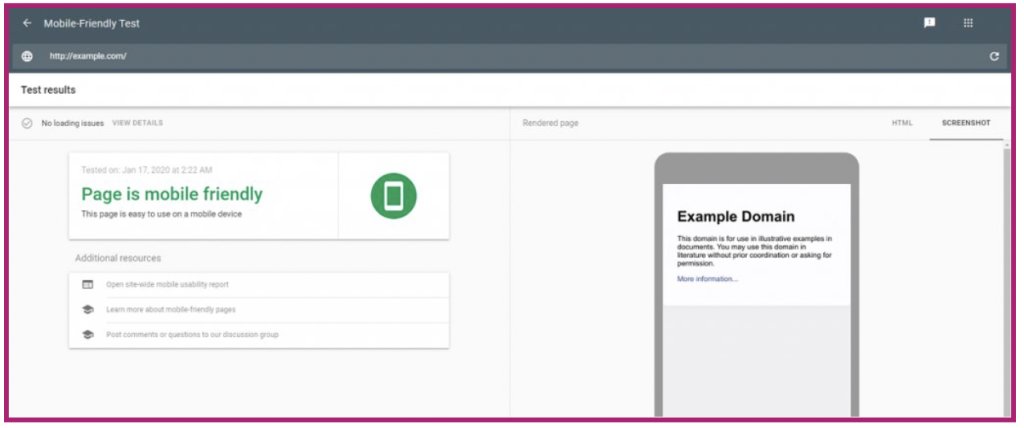
Key conversion optimization tips for small business websites
Small businesses often spend money on ads to get leads more quickly. But with their tight budgets, putting all cash into ads instead of converting website visitors into leads might not be a smart move. Limited money, lack of expertise, and not enough traffic to run tests are some issues small businesses encounter. But here are some ways small businesses can still ace website optimization:
1. Look at how visitors behave
By checking out what visitors do on your site, like where they click or scroll, you can see where things might be confusing or not working right. You can use tools like heatmaps and session recordings to help figure this out. Then, you can make changes to make it easier for visitors to use your site.
2. Listen to what customers say
Surveys are a great way to get feedback directly from customers. They can tell you what they like and what they find difficult about your website or products. This feedback can help you make changes to make things better for them, which can lead to more satisfied visitor experiences.
3. Watch how people use your site
Usability testing lets you watch real people use your website. You can see where they get stuck or frustrated, and then you can fix those things to optimize your site for more conversions.
4. Make your website load faster
Online customers demand that websites load faster, as they are spoiled for choice today. Failure to meet this expectation drives customers away to competitors who offer faster and more seamless experiences. By making your website load faster, you can keep visitors on your site longer, thereby persuading them to take the necessary actions on your website.
5. Ensure mobile responsiveness
Given the prevalent use of smartphones today, your website must perform well on mobile devices. A mobile-responsive website adjusts its layout and design to fit different screen sizes, making it easier for visitors to navigate and engage with your content on their phones or tablets.
The essential guide to eCommerce optimized website
eCommerce website optimization is a multifaceted approach aimed at transforming visitor interactions into conversions and maximizing revenue generation. This involves fine-tuning various elements to create a seamless and engaging user experience.
By prioritizing factors such as website design, navigation ease, and fast loading times, businesses can stand out amidst fierce online competition.
Personalization plays a pivotal role in eCommerce optimization, as tailored experiences cater to individual preferences and enhance customer satisfaction. By leveraging data analytics and customer insights, businesses can deliver targeted offers, recommendations, and content, fostering a deeper connection with users and driving purchase decisions.
In addition to optimizing the user experience, enhancing technical aspects such as website speed, mobile responsiveness, and search engine visibility are equally essential. Fast-loading pages, mobile-friendly design, and strategic SEO practices contribute to increased organic traffic and improved search rankings, expanding the reach of the eCommerce store.
Continuous experimentation through A/B testing enables businesses to refine their strategies and identify the most effective tactics for driving conversions. By analyzing user behavior, businesses can gain valuable insights into customer preferences and optimize website elements accordingly, maximizing engagement and sales.
Overall, eCommerce website optimization is a dynamic and ongoing process that requires vigilant monitoring, adaptation to evolving trends, and a commitment to delivering exceptional customer experiences.
The ultimate list of website optimization tools
To try to optimize your site manually would be like going into the forest to forage for your own food.
Instead, you can use this extensive list of tools to help your optimization efforts:
Performance and speed optimization tools
Below mentioned are some of the top-rated testing tools in the market, that help in pinpointing issues related to page loading and speed. These tools offer invaluable insights into website performance, facilitating the identification and resolution of speed-related issues.
- Google PageSpeed Insights
- GTmetrix
- WebPageTest
- Pingdom
- YSlow
- Dareboost
Search engine optimization (SEO) tools
Discover essential SEO tools to elevate your Google SERP rankings. These comprehensive tools empower you with functionalities like keyword research, on-page optimization, backlink analysis, site audits, and competitor tracking, enhancing your site’s searchability and audience connection.
- Ahrefs
- SEMrush
- Moz Pro
- Screaming Frog
- Google Search Console
- KWFinder
Check out this article to explore a comprehensive list of various types of website optimization tools.
Website optimization checklist
At over 5,000 words, we’ve covered a lot of information in this guide so far. It’s probably difficult to keep track of all the information, much less actually use the advice.
To make it easier to implement the tactics and ideas, we’ve distilled each aspect into a checklist you can use when optimizing your website.
Checklist for optimizing your website’s loading speed:
- Use a CDN for media files and scripts.
- Implement Lazy Loading.
- Use responsive images on your site.
- Compress your images before uploading them.
- Reduce the number of HTTP requests.
- Use a caching plugin (If you use a CMS).
- Enable browser caching.
- AMP conversion of high-traffic pages.
Checklist for optimizing your website’s SEO:
- Check for basic SEO/Sitemap/Indexing errors with Search Console.
- Research what your customers are searching for.
- Use short URLs/Permalinks that describe your content.
- Optimize images with alt tags and descriptive file names.
- Follow the correct headline structure using a single H1, then H2s and H3s.
- Link to important internal pages.
- Write a compelling SEO title that will drive a high CTR in the SERPs.
- Win backlinks by creating complex content like videos, case studies, or white papers.
- Keep a track of search engine algorithm update.
Checklist for optimizing your website’s conversion rate:
- Know your target audience and write for them in your web copy.
- Cover common pain points in your headlines.
- Highlight features instead of benefits.
- Optimize the user experience.
- Use social proof to build trust with your audience.
- Use white space and positioning to highlight important elements.
- Always include a persuasive CTA on key pages.
- Test everything from headlines, CTA placements, and images to form design.
- Create a conversion funnel that uses a variety of channels.
ChatGPT prompts for CRO: Your handy optimization resource
The mention of AI can often evoke a sense of apprehension among CRO professionals today. However, it’s crucial to debunk the myth that AI is a threat looming over job security and business sustainability. Instead, adapting to AI can benefit us in the most effective ways. At the forefront of this AI revolution stands ChatGPT, a Gen-AI system that aids in data collection, analysis, and content creation. ChatGPT’s made waves in different sectors, and it’s also handy for CROs. Below we explore some prompts tailored to supercharge your productivity and streamline your optimization efforts.
Get testing ideas
When you hit a roadblock in testing ideas, seeking ideas from ChatGPT can help overcome creative hurdles. Simply enter your prompts to get testing ideas and suggestions to improve websites, leading to ongoing enhancements and better outcomes.
An example: Put yourself in the shoes of a CRO expert and think of testing ideas for your eCommerce product page.
Understand customers’ needs
Create testing plans that address real customer issues. Based on your prompts, ChatGPT swiftly provides a list of these pain points, helping you understand audience needs and make meaningful improvements.
An example: As the owner of an event management company in Michigan, what common challenges do our local customers encounter? How can I tweak my website to solve these issues and provide a smoother experience?
Craft targeted copy
ChatGPT can help overcome writer’s block by giving customized suggestions for headlines, CTAs, and product descriptions. With clear prompts, you’ll get personalized ideas that make your copy more relevant and effective.
An example: Suggest four unique hero banner titles for new visitors and four for returning visitors on the homepage of my doctor appointment booking website.
Navigate CRO goals
To achieve optimal results in CRO, it’s essential to strike a balance between micro and macro conversions. ChatGPT can help identify both types of goals tailored to your website, along with providing benchmark data for tracking website performance and meeting business objectives.
An example: Could you make a list of both micro and macro conversion goals we need to track on our consulting website? It would be great if you could also find benchmark data for these to measure our performance.
Conclusion
It’s not enough to just have a website for your business. You have to carefully design and optimize it to consider search engines, your ideal customers, and other factors.
After reading this comprehensive guide, you should have no problem getting started with optimization, and creating your plan of attack.
Make sure you follow our tips and guidelines to avoid mistakes and use our list of tools to not only speed up the process but give you insights you couldn’t get without them.
Even succeeding in a single area can have a massive impact on your bottom line. If you keep experimenting and testing over time, you can use SEO, CRO, and UX improvements to transform your business.
Frequently asked questions on website optimization
Web optimization is the process of using tools, advanced strategies, and experiments to improve the performance of your website, and its user experience, and to increase its visibility on search engines, thereby driving more traffic and conversions.
If your company doesn’t optimize its website, it doesn’t matter how many people search for terms relevant to your business; your website is not going to show up in the results. And unfortunately, your website and your business won’t get noticed by anyone. So all your efforts to promote your business online would go in vain. Know more about website optimization in this guide.
The first step of website optimization is to identify friction areas and experience breakages in the conversion funnel. It would be best if you found out what’s wrong with your current website before you can improve it. That’s the foundation of any good optimization process.
There are various strategies for website optimization. Some of them include doing SEO for your website, tailoring your website copy as per your target audience, A/B testing, improving your page speed and optimizing the mobile experience of your website, and so on.


